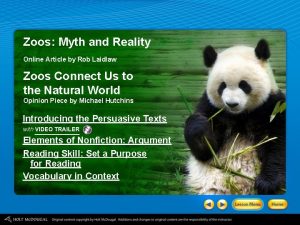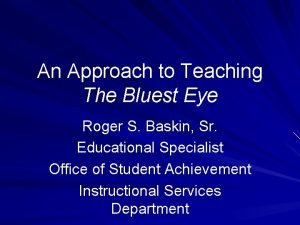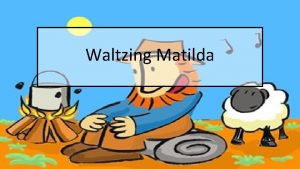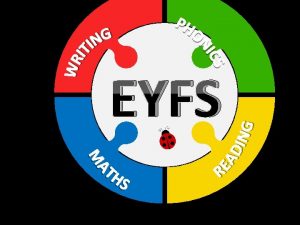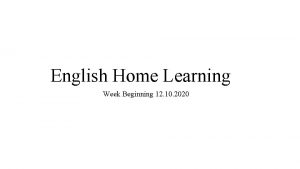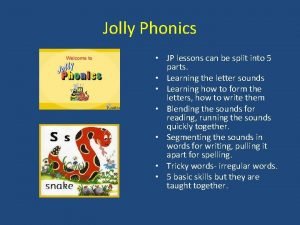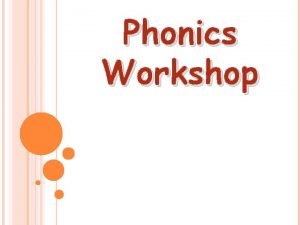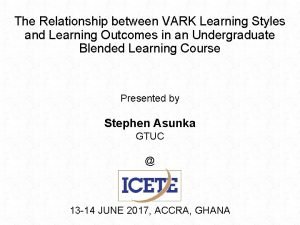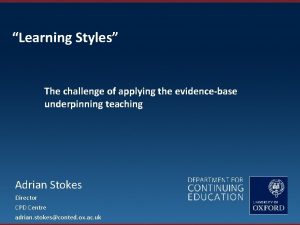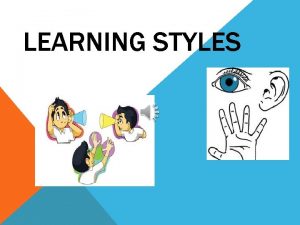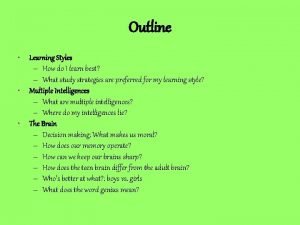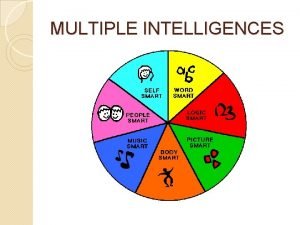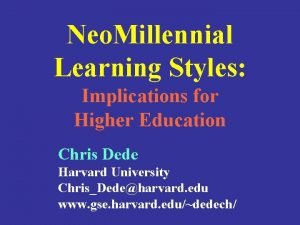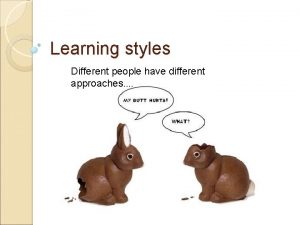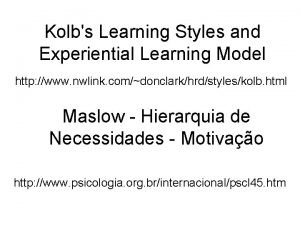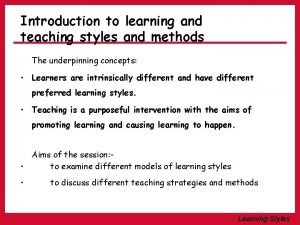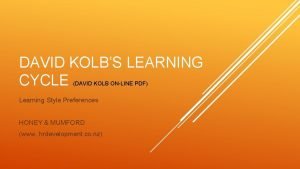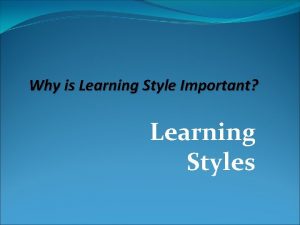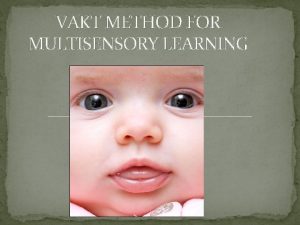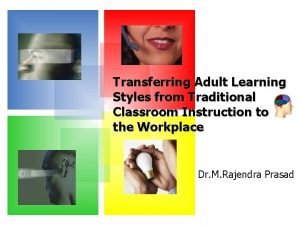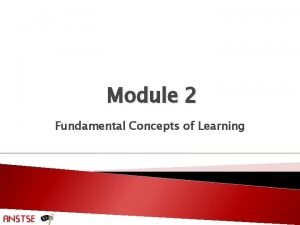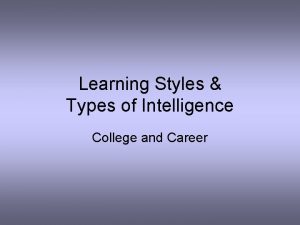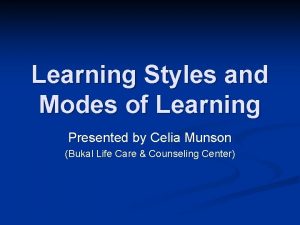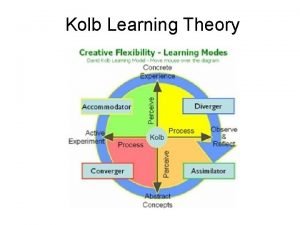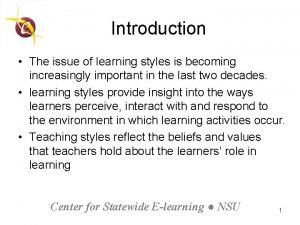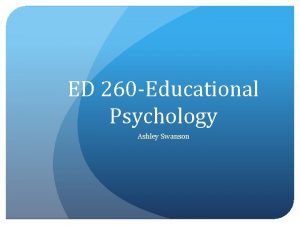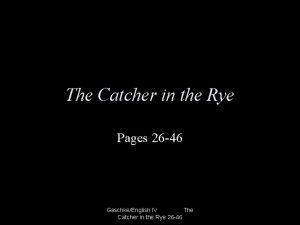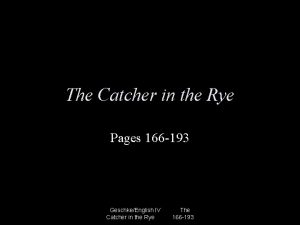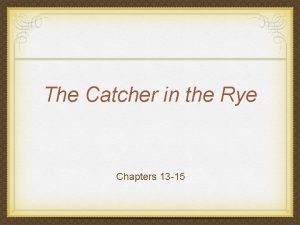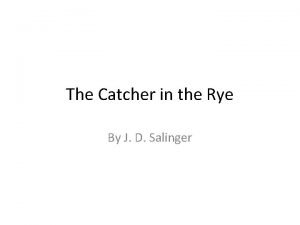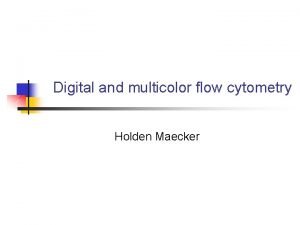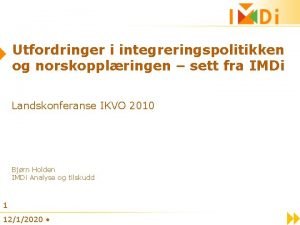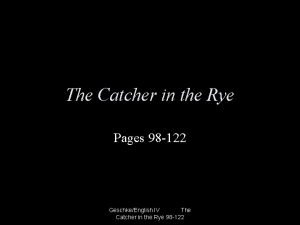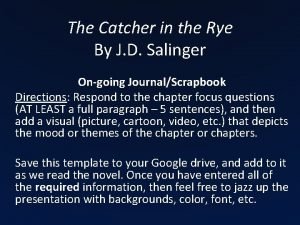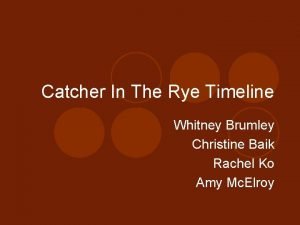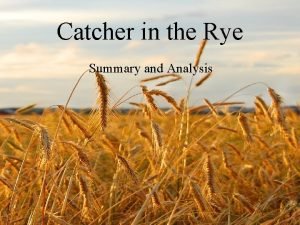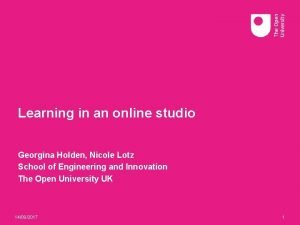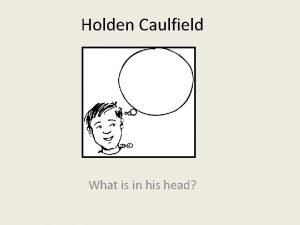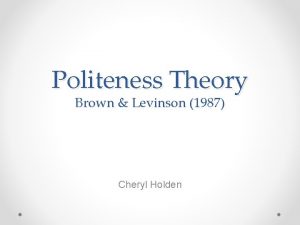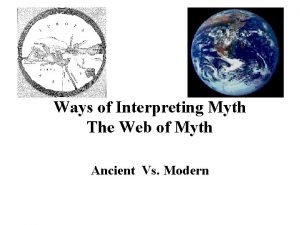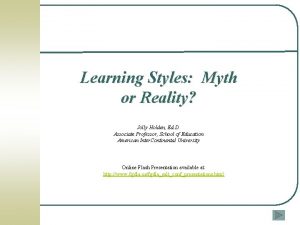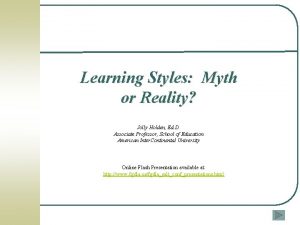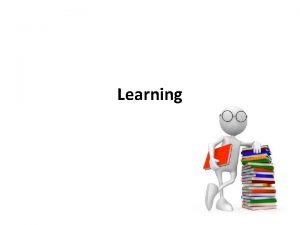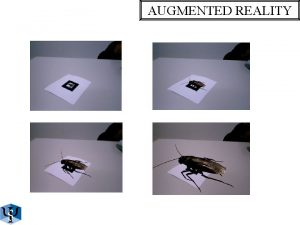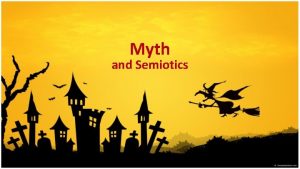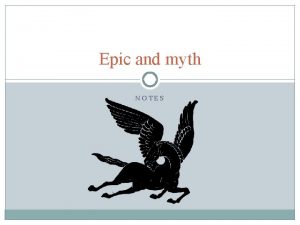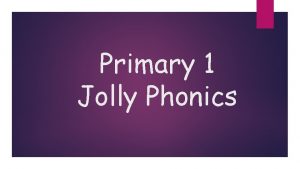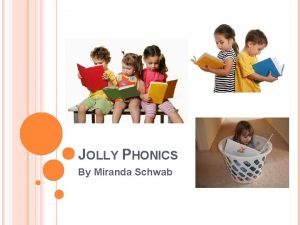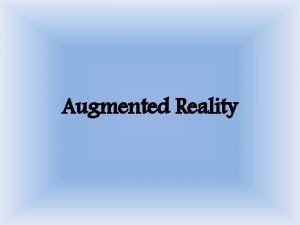Learning Styles Myth or Reality Jolly Holden Ed





![Insight [and research] into Learning Styles • A recent study published in the Psychological Insight [and research] into Learning Styles • A recent study published in the Psychological](https://slidetodoc.com/presentation_image_h2/55d091704e4c2178874350aaa80b7ed2/image-6.jpg)







![The Essence of the Debate [and the disagreement] l Learning style theorists look at The Essence of the Debate [and the disagreement] l Learning style theorists look at](https://slidetodoc.com/presentation_image_h2/55d091704e4c2178874350aaa80b7ed2/image-14.jpg)
![The Essence of the Debate [and the disagreement] l No current holistic [overall] theory The Essence of the Debate [and the disagreement] l No current holistic [overall] theory](https://slidetodoc.com/presentation_image_h2/55d091704e4c2178874350aaa80b7ed2/image-15.jpg)
![Predicting Learning Styles: The Basis of the Theory [and the confusion] l The genesis Predicting Learning Styles: The Basis of the Theory [and the confusion] l The genesis](https://slidetodoc.com/presentation_image_h2/55d091704e4c2178874350aaa80b7ed2/image-16.jpg)
![Predicting Learning Styles: The Basis of the Theory [and the confusion] • The assumption Predicting Learning Styles: The Basis of the Theory [and the confusion] • The assumption](https://slidetodoc.com/presentation_image_h2/55d091704e4c2178874350aaa80b7ed2/image-17.jpg)
































































- Slides: 81

Learning Styles: Myth or Reality? Jolly Holden, Ed. D. Associate Professor, School of Education American Inter. Continental University Online Flash Presentation available at: http: //www. fgdla. us/fgdla_salt_conf_presentations. html

Why Are You Here? Opinion: The concept of learning styles in predicting learning outcomes is probably the most misunderstood and misapplied instructional concept confronting educators and trainers today. Fact: Research has revealed that learning styles have little, if any, effect on predicting learning outcomes. In fact, there is no evidence that instructors succeed in improving learning by attempting to diagnose student learning styles, and adjusting instruction accordingly for the individual students. Result: So why is there so much discussion on them and why are they still widely perceived as having an effect?

Goals of This Presentation Inform--What are learning styles and how do they differ from learning modalities? Educate--What does the research indicate? The facts based on research, not Google. Enlighten—So what? Why so much confusion? What can trainers/instructional designers do to facilitate the transfer of learning?

Do You Know Your Learning Style? Are you a… Converger; diverger; assimilator; accommodator (Kolb’s learning styles inventory) Concrete sequential; abstract random; abstract sequential; concrete random (Gregorc’s learning style topography) Sensory/intuitive; visual/verbal; active/reflective; sequential/global (Felder & Solomon four-dimension model) Activists; reflectors; pragmatists; theorists (Honey & Mumford's learning styles) Messick: Analytic/non-analytic; conceptualizing Convergent/divergent thinking (Guilford’s model of intellect) Field dependent/field independent (Witkin’s cognitive styles) Visual, aural, kinesthetic (Dunn & Dunn VAK learning styles)

Presentation Menu (Click any of the hyperlinks to go directly to that topic) l l l The “So What” The Debate What are Learning Styles? • What are Learning Modalities? • What’s the Difference? • The Learning Style Hypothesis • Review of the Research • What Does it All Mean & What Can I Do? What Do the Experts Say? Cognitive Styles Learning/Cognitive Style Resources Prior Return Next slide to Menu slide
![Insight and research into Learning Styles A recent study published in the Psychological Insight [and research] into Learning Styles • A recent study published in the Psychological](https://slidetodoc.com/presentation_image_h2/55d091704e4c2178874350aaa80b7ed2/image-6.jpg)
Insight [and research] into Learning Styles • A recent study published in the Psychological Science in the Public • Interest challenged the prevailing concept of learning styles and their affect on student performance. The investigators (four prominent cognitive psychologists) found “no evidence…for validating the educational applications of learning styles into general educational practice. ” To that end, in a 2010 article appearing in the Australian Journal of Educational Research stated “research conducted over the last 40 years has failed to show that individual attributes can be used to guide effective teaching practice”. This is not surprising…these results and conclusions have been supported repeatedly in the research for the past 30 years.

So What? • This is not a new debate but a continuing investigation into the efficacy • • of learning styles that has spanned 60 years. To that end, there is a strong intuitive appeal to the notion there are individual preferences and styles of learning. That said, we’re not going to solve the problem today, but… at the end of this presentation, you will better understand the concept of learning styles, the reliability and variability of the instruments used to identify them, and impact [or lack thereof] on learning.

Given the Research, Why the Debate? You can thank Google for that…the Google “effect” blurs one’s perception when attempting to distinguish valid research from lore. Google search results Search terms learning styles “learning styles” (site: com) “learning styles” (site: org) “learning styles” (site: edu) Results >37, 000 >13, 500, 000 ~4, 990, 000 ~840, 000 ~380, 000 Note: Google can only search the WWW…it cannot search the deep web. The majority of research data is only available on the deep web.

What Google Doesn’t Know and Can’t Find: The Deep Web Now, let’s see what a comprehensive, university library database reveals when searching the Deep Web. Note: Google currently indexes ~23. 5 billion out of the 300+ billion pages out there. . . less than 8% of all available internet content. The other 92% is located in the deep web. Search terms learning styles cognitive styles Results 5, 608 950 This university library has the capability to search thousands of databases comprising over 18, 000 peer reviewed (refereed) journals encompassing ~1, 464, 000 annual journal articles in specific disciplines from the past 2 decades. The total articles searched exceeds 28, 000.

What are Learning Styles? l l l Basically, learning styles refers to the concept that individuals differ in regard as to what specific mode in acquiring information is most effective for them, and that learning styles are not a fixed trait, but a differential preference for learning. However, learning style definitions are characterized by considerable conceptual confusion and the lack of any generally accepted definition. Many educational/cognitive psychologists believe learning styles are a myth…that while individual differences in learning exists, they are a result of acquired/innate preferences but do not affect learning anymore than the truck delivering groceries to your local store affects your dietary habits.

What are Learning Modalities? l l l Learning, or perceptual modalities, are sensory based and refer to the primary way our bodies take in information though our senses: visual (seeing), auditory (hearing), kinesthetic (moving), and tactile (touching). Humans are multi-sensory in that the brain performs several activities at once when processing information (e. g. , tasting and smelling, hearing and seeing), but are processed through different channels in our brain. While the brain processes wholes and part simultaneously, learning engages the whole body. Note: Multi-sensory processing is not the same as multi-tasking (partial tasking) in that the brain is not very good at multi-tasking, per se, attempting to perform multiple tasks simultaneously.

What’s the Difference? • Not surprisingly, there is substantial confusion between learning styles • • and learning modalities where the terms are often used interchangeably. One of the reasons is the complexity of how the human brain functions as it relates to one’s modalities in receiving information (visual, aural, kinesthetic) and how the brain processes that information (cognition). An important finding from that research is that retention is generally independent of the modality used to acquire whatever is learned.

What’s the Difference? • You typically store memories in terms of meaning-- not in terms of • • • whether you saw (visual), heard (aural), or physically (tactile/kinesthetic) interacted with the information. To that end, our brain is constantly searching its memory for context based on prior knowledge/experience. In the absence of visual cues, our brains create “mental pictures” based upon our schema to add context to what is printed/spoken. Click here for an example. The fact is, we don’t learn based upon style…we learn based upon meaning (context). Click here for a example.
![The Essence of the Debate and the disagreement l Learning style theorists look at The Essence of the Debate [and the disagreement] l Learning style theorists look at](https://slidetodoc.com/presentation_image_h2/55d091704e4c2178874350aaa80b7ed2/image-14.jpg)
The Essence of the Debate [and the disagreement] l Learning style theorists look at how students learn, not what they learned. • • Based upon information acquisition theory of multimedia learning which holds that learning consists of receiving information Assumes people learn by adding information to memory, “as if the mind were an empty vessel that needs to be filled with information” (Clark & Mayer, Elearning and the Science of Instruction, 3 rd Ed. , 2011) l By emphasizing the how of instruction, learning styles practitioners lose sight of the what of instruction and tend to “profile” learners based upon perception. Note: Neuroscience has estimated 85% of the human brain is wired to process visual information, and that 90% of what the brain processes is visual information, so one’s primary learning modality is visual.
![The Essence of the Debate and the disagreement l No current holistic overall theory The Essence of the Debate [and the disagreement] l No current holistic [overall] theory](https://slidetodoc.com/presentation_image_h2/55d091704e4c2178874350aaa80b7ed2/image-15.jpg)
The Essence of the Debate [and the disagreement] l No current holistic [overall] theory of learning preferences. • The point being that what is commonly referred to as learning styles, others have labeled as cognitive styles, learning preferences, learning capabilities, cognitive control, multiple intelligences, etc. • Not supported by available research evidence that “visualizers” learn better with visual forms of instruction and “verbalizers” learn better with verbal modes of instruction. “Review of 150 studies found none supported learning styles. The mind is so complex and malleable that variance within a person is so great as to make the point [learning styles] moot. ” Busted Learning Myths, Chief Learning Officer Magazine, Feb 2012
![Predicting Learning Styles The Basis of the Theory and the confusion l The genesis Predicting Learning Styles: The Basis of the Theory [and the confusion] l The genesis](https://slidetodoc.com/presentation_image_h2/55d091704e4c2178874350aaa80b7ed2/image-16.jpg)
Predicting Learning Styles: The Basis of the Theory [and the confusion] l The genesis of the [VAK] theory of learning styles is that if you can design instruction that matches a student’s “style”, they should learn better: • • • The visual learner will understand best when information (content) is presented to the visually. The auditory learner will understand best when information is described to them orally. The kinesthetic learner will understand best when they can touch/fell the what is being presented to them. These are statements of predictability, per se, you are predicting learning outcomes based upon learning “styles”
![Predicting Learning Styles The Basis of the Theory and the confusion The assumption Predicting Learning Styles: The Basis of the Theory [and the confusion] • The assumption](https://slidetodoc.com/presentation_image_h2/55d091704e4c2178874350aaa80b7ed2/image-17.jpg)
Predicting Learning Styles: The Basis of the Theory [and the confusion] • The assumption is once you identify a specific style, you can design instruction that best fits the style. • • However, there is no evidence that knowledge of one’s learning styles is a benefit to learning. Furthermore, there is no evidence that instructors succeed in improving learning by attempting to diagnose student learning styles, and adjusting instruction accordingly for the individual students.

The Learning Style Hypothesis: True or False? The hypothesis of the learning styles theory is as follows: Learning is optimal if the learning method is matched to the student’s learning style. As with any scientific hypothesis, two key questions should be asked: 1. How would we know the hypothesis is true, or what type of evidence would show that the hypothesis is true? 2. How would we know the hypothesis is not true, or what type of evidence would show that the hypothesis is not true?

The Learning Style Hypothesis: True or False? “Based upon the most thorough review of experimental studies known to date, which sought to objectively find answers either in support of or against the hypothesis described prior, did not find evidence in favor of the learning styles hypothesis, per se, that learning is more effective when teaching matches the learner’s style”. * Learning Styles: Concepts and Evidence, Psychological Science in the Public Interest, 2008 The theory of learning styles is attractive, and it sounds like common sense. It is also convenient, offering a rationale of escaping accountability and getting rid of responsibility. Learning Styles Fray: Brilliant or Batty? Performance Improvement, Vol 49, Number 10 , 2010

What Does the Research Reveal About Learning Styles? • Simply stated, the research has not revealed a compelling argument as • to the impact of learning styles and their effect on predicting learning outcomes. Research does not support designing instruction to match learning styles. • • After more than 30 years of research, no consensus has been reached about the most effective instrument for measuring learning styles and there is no agreement about the most appropriate pedagogical interventions. No substantial, uncontested, and hard empirical evidence has been found to prove that matching the styles of learner and instructor improves learning and attention.

What Does the Research Reveal About Learning Styles? • Postulates learning/cognitive styles have <5% effect on the variability • • in learning. The majority of research does not support a significant statistical relationship between learning/cognitive styles and learning outcomes. Small sample sizes, flawed sampling methodology, and nonexperimental research designs casts doubt on the results of VAK learning style research. Based on several decades of empirical evidence, matching learning activities/ strategies with specific learning styles does not often result in improved learning. Dr. Allan Jeong, Associate Professor, Dept. of Educational Psychology and Learning Systems, Florida State University

What Does the Research Reveal About Learning Styles? • Low validity and reliability scores of the VAK instruments used to • identify specific learning styles raise serious doubts about their psychometric properties. In other words, if the tests used to identify learning styles are not reliable or valid, then any conclusions or results based upon them are suspect. • These tests are not controlled in their distribution and/or reproduction, or administered under controlled conditions.

What Does the Research Reveal About Learning Styles? • • • Scores on the VAK learning style tests vary greatly among same individual. VAK test questions focus on out-of-context preferences which allows for wide range of interpretations. Learning style instruments tend to be self-assessments that rely on students to answer honestly and to have enough self-awareness to answer accurately. Intervening variables confound the results Assessment of learning styles based on sensory modality has no correlation with learning and memory. Research reveals that most learning style instruments have such serious weaknesses (e. g. low reliability & poor validity) it is recommend their use in research and practice should be discontinued. Investigations of the properties of a variety of scales have revealed that even the most widely used are inadequate in this regard. Australian Journal of Education, Vol. 54, No. I, 2010, 5 -17

Given the Research, Why all the Confusion? • It’ s not surprising the reference to learning styles is one of the most misunderstood and overused issues confronting educational and training communities. • Part of the reason is the wide disparity in the definition of learning styles and their relationship to cognitive styles. • Furthermore, there is continued debate as to whether learning styles even exist, with the only current evidence of their existence being the tests used to identify them. • Confusion is further exacerbated in that research has identified over 71 different types of learning styles (Table 1), summarized into the 13 most influential models (Table 2), and families (Table 3).

Cut to the Chase—What Can I Do? l l Cognitive science has revealed learners differ in their abilities with different modalities, but teaching to a learner’s best modality doesn't affect learning outcomes. What does matter is whether the learner is taught in the content's best modality…people learn more when content drives the choice of modality. Note: Although neuroscience has revealed 90% of what the brain processes is visual information, most learners are multi-modal and multi-sensory and adapt their strategies accordingly.

Design Techniques: Facilitating the Transfer of Learning l Avoid cognitive overload in multimedia design. l l l Cognitive Overload Theory focuses on the role of working memory in instructional design. Meaningful learning depends on active cognitive processing in learner’s working memory. If learners encounter too many elements in the presentation of multimedia information (animation, graphics, sound, text), working memory can be overwhelmed § Result is excessive cognitive load that impedes learning.

Design Techniques: Facilitating the Transfer of Learning l l l Integrate cognitive learning strategies into the design of instructional to facilitate transfer of knowledge (click here for more) Review the Cognitive Information Processing model (click here for more). Integrate Cognitive Flexibility Theory in design of instruction (facilitates the acquisition of knowledge). l Accomplished by revisiting the same material, at different times, in rearranged contexts, and from different conceptual perspectives.

Design Techniques: Facilitating the Transfer of Learning l Employ dual-coding theory: When content is presented through two different channels (visual and auditory), working memory can be increased (click here for more on dual-coding theory). • Adds context to the written/spoken word. • Retention is improved through words and pictures (visual media) rather than through words alone.

Conclusion • Learning styles provide no indication of what the students are capable • • • of, nor are they legitimate excuses for poor academic performance. Assume all students have an intrinsic motivation to learn. Recognize the complexity in learning and that individuals do learn differently. Don’t constrain learning by “profiling” (aka categorizing/ labeling) students based on learning styles. “learning styles‘ theory appeals to the underlying culture's model of the person ensures theory's continued survival, despite the evidence against its utility. Rather than being a harmless fad, learning styles theory perpetuates the very stereotyping and harmful teaching practices it is said to combat. ” Australian Journal of Education, Vol. 54, No. I, 2010, 5 -17

Final Note ü The research on how we learn has generally ignored the agility of humans in being able to adapt to different learning environments. ü The research has grossly understated the internal fortitude of humans to employ multiple learning “preferences” in their endeavor to learn. ü As educators and trainers, we must never underestimate the ultimate trump card that represents the single most important variability in learning…the will to learn. Research has indicated prior knowledge and intrinsic motivation account for ~70% of the variability in learning.

The End: “A man only needs two. Questions? tools in life: WD-40 to make things go, and duct tape to make them stop. ” G. M. Weilacher, American humorist “and a hammer to pound things in and a screw driver to pry them out. ” my wife Prior Return slide to Menu

Intentionally Left Blank Click this button to return to the prior slide

What are Cognitive Styles? l l Cognitive styles are viewed as a bipolar dimension representing a person's typical or habitual mode of problem solving, thinking, perceiving and remembering; are considered stable over time, and related to theoretical or academic research. Cognitive styles primarily focus on cognition and how information is processed in the brain.

What Does the Research Reveal About Cognitive Styles? • The research pertaining to cognitive styles is quite different than • learning styles in that the reliability and the validity of the instruments used to identify them are much more robust. The most researched cognitive style is Herman Witkin’s Field Dependence/Field Independence (more on FD/FI here). • The test used to identify Field Dependence (FD) and Field Independence (FI) is the Embedded Figures Test • Highly reliable and valid (Cronbach Alpha >80%) • However, research on cognitive styles has declined in recent years due to the fuzziness between cognitive styles and abilities, assumption that cognitive styles are innate while abilities are acquired.

Intentionally Left Blank Click this button to return to the prior slide

Describing and “Seeing” the Constellation Orion • The constellations are totally imaginary things that have been made up over • Return to main presentation • • • the past 6, 000 years. So how would you describe something imaginary to your students? You may begin by describing the three bright stars in a row that form Orion’s belt and the other stars that form his sword. But your students have trouble “visualizing” how the stars shape the figure of Orion. To assist them in creating a mental picture, you show them a star chart of Orion to help them “visualize” this imaginary figure. But they still can’t quite get it, so to further enhance their mental image, you show them another detailed chart depicting Orion. The aha moment…they got it because they now can “see” Orion, so they conclude they must be visual learners. But…are they really visual learners or did you create the visual image for them by adding context to the description?

Orion Star Chart Return to prior slide

Orion Figure Outlined in a Star Chart Return to prior slide

The Constellation Orion Return to prior slide

Intentionally Left Blank Click this button to return to the prior slide

Example Given the depiction of a power line in the map on the left, identify the power line in the aerial photo on the right. Return to main presentation

Example If you cannot find the power line, it may be due to your prior knowledge (schema) of what power lines should look like, such as the ones depicted below. Since there are no other visual cues to add context to your prior “visual images”, and due to lack of past experiences, you may not be able to locate the power line. Return to main presentation

Example So lets add some context (meaning). Don’t look for the actual power line structure…instead look where the power line might be. Return to main presentation It’s not a matter of “seeing” the actual power lines or visual acuity…it’s a matter of context.

Example Return to main presentation Still can’t locate it? Here’s another image – look for the path of the power line (right-of-way) instead of the actual structures. Result: Given a different context, you identify the power line path not from your prior knowledge but instead based upon an entirely different context. You have now added a new concept to your schema, which could also be applied to similar situations. Click for final image/click again to turn off

Intentionally Left Blank Click this button to return to the prior slide

Table 1: Types of Learning/Cognitive Styles* Return to main presentation convergers vs. divergers verbalisers vs. imagers holists vs. serialists deep vs. surface learning activists vs. reflectors pragmatists vs. theorists adaptors vs. innovators assimilators vs. explorers field dependent vs. field independent globalists vs. analysts assimilators vs. accommodators imaginative vs. analytic learners intuitionists vs. analysts extroverts vs. introverts seeing vs. hearing sensing vs. intuition thinking vs. feeling non-committers vs. plungers common-sense vs. dynamic learners concrete vs. abstract learners random vs. sequential learners initiators vs. reasoners judging vs. perceiving left brainers vs. right brainers meaning-directed vs. undirected theorists vs. humanitarians activists vs. theorists pragmatists vs. reflectors organizers vs. innovators analytics/inductives/successiv e processors vs. globals/deductivess/simultane ous processors executive, hierarchic, conservative vs. legislative, anarchic, liberal * Coffield, F. , Moseley, D. , Hall, E. , & Ecclestone, K. (2004). Learning styles and pedagogy in post-16 learning. Learning Skills and Research Centre, London. Retrieved from http: //www. leerbeleving. nl/wp-content/uploads/2011/09/learning-styles. pdf

Intentionally Left Blank Click this button to return to the prior slide

Table 2: Most Influential Models of Learning/Cognitive Styles* Return to main presentation Allinson and Hayes’ Cognitive Styles Index (CSI) Apter’s Motivational Style Profile (MSP) Dunn and Dunn model and instruments of learning styles Entwistle’s Approaches and Study Skills Inventory for Students (ASSIST) Gregorc’s Mind Styles Model and Style Delineator (GSD) Herrmann’s Brain Dominance Instrument (HBDI) Honey and Mumford’s Learning Styles Questionnaire (LSQ) Jackson’s Learning Styles Profiler (LSP) Kolb’s Learning Style Inventory (LSI) Herman Witkin’s Field Dependent (FD) & Field Independent (FI) Riding’s Cognitive Styles Analysis (CSA) Sternberg’s Thinking Styles Inventory (TSI) Vermunt’s Inventory of Learning Styles (ILS) * Coffield, F. , Moseley, D. , Hall, E. , & Ecclestone, K. (2004). Learning styles and pedagogy in post-16 learning. Learning Skills and Research Centre, London. Retrieved from http: //www. leerbeleving. nl/wp-content/uploads/2011/09/learning-styles. pdf

Intentionally Left Blank Click this button to return to the prior slide

Table 3: Families of Learning/Cognitive Styles* Return to main presentation Learning styles are largely sensory based Learning styles reflect deep-seated cognitive structure Learning styles reflect relatively stable personality type Betts (1909) Betts Inventory Bartlett (1932) Gordon (1949) Scale of Imagery Control Scheehan (1967) Shortened Betts Inventory Paivio (1971) Individual Difference Questionnaire (IDQ) Marks (1973) Marks Vividness of Visual Imagery Questionnaire Dunn and Dunn (1975, 1979, 1992, 2003) VAK Learning Style Learning Theory Torrance (1990) Style of Learning and Thinking Riding (1991) Cognitive Style Analysis (CSA) Guilford (1950) Convergent/divergent thinking Prettigrew (1958) Scale of Cognitive Style Gardner et al. (1959) Tolerant/ intolerant Broverman (1960) Kagen (1967) Matching Familiar Figures Test Messick (1976) Analytic / nonanalytic conceptualizing Hunt (1978) Paragraph Completion Method Cooper (1997) Learning Styles ID Weinstein, Zimmerman, Palmer (1988) Learning and Study Strategies Inventory Witkin (1962) Field Dependent (FD/Field Independent (FI); Group Embedded Figure Test (GEFT) Apter (1998) Motivation Style Profile (MSP) Epstein-Meier (1989) Constructive Thinking Inventory (CTI) Miller (1991) Personality typology: cognitive, affective Harrison- Branson (1998) revised Inquiry Mode Questionnaire Jackson (2002) Learning Style Profiles (LSP) Learning styles are flexibly stable learning preferences Kolb (1976, 1985, 1999) Learning Style Inventory (LSI) Schmeck (1977) Inventory of Learning Processes Honey and Mumford (1982) Learning Style Questionnaire (LSQ) Felder and Silverman (1989) Index of Learning Styles (ILS) Kaufmann (1989) The A-E Inventory Allinson and Hayes (1996) Cognitive Style Index (CSI) Herrmann (1995) Brain Dominance Instrument (BDI) * Coffield, F. , Moseley, D. , Hall, E. , & Ecclestone, K. (2004). Learning styles and pedagogy in post-16 learning. Learning Skills and Research Centre, London. Retrieved from http: //www. leerbeleving. nl/wp-content/uploads/2011/09/learning-styles. pdf

Intentionally Left Blank Click this button to return to the prior slide

Resources l l l Coffield, F. , Moseley, D. , Hall, E. , & Ecclestone, K. (2004). Learning styles and pedagogy in post-16 learning. Learning Skills and Research Centre, London. Retrieved from http: //www. leerbeleving. nl/wp-content/uploads/2011/09/learningstyles. pdf Clemons, Stephanie (2005). Brain-Based Learning: Possible Implications for Online Instruction. International Journal of Instructional Technology and Distance Learning, September 2005, Vol. 2. No. 9. Retrieved from http: //www. itdl. org/Journal/Sep_05/article 03. htm Cognitive/Learning Styles (n. d. ). Theory Into Practice, Retrieved from http: //tip. psychology. org/styles. html Curry, L. (1990). A critique of research on learning styles. Educational Leadership, 56(2), 50 -56. Retrieved from http: //www. ascd. org/ASCD/pdf/journals/ed_lead/el_199010_curry. pdf De. Ture, M. (2004). Cognitive Style and Self-Efficacy: Predicting Success in Online Education. The American Journal of Distance Education, 18(1), 21 -38. Retrieved from http: //test. scripts. psu. edu/users/k/h/khk 122/woty/AJDE/De. Ture%202004. pdf

Resources l l l Dumbo, Myron H. , & Howard, K. (2007). Advice about the Use of Learning Styles: A Major Myth in Education. Journal of College Reading and Learning, v 37 n 2 p 101 -109 Spr 2007. Retrieved from: http: //www. eric. ed. gov/ERICWeb. Portal/search/detailmini. jsp? _nfpb=true&_&ERICExt Search_Search. Value_0=EJ 767768&ERICExt. Search_Search. Type_0=no&accno=EJ 7 67768 Howles, S. (n. d. ). Learning styles: What the Research Says and How to Apply it to Designing E-Learning. Session TH 101, University of Wisconsin-Madison. Retrieved from http: //isg. urv. es/library/papers/learning%20 styles_overview. pdf Learning Orientation Research: Individual Differences in Learning (2004). Retrieved from http: //www. trainingplace. com/source/research/cronbach. htm Learning styles and pedagogy in post-16 learning: A systematic and critical review. (2008). Learning and Skills Research Centre, Department for Education and Skills, UK (2004). Retrieved from http: //www. hull. ac. uk/php/edskas/learning%20 styles. pdf Liu, Y. & Ginther, D. (1999). Cognitive Styles and Distance Education. Online Journal of Distance Learning Administration, Volume II, Number III, Fall 1999. Retrieved from http: //www. westga. edu/~distance/liu 23. html

Resources l l Matching Teaching Style to Learning Style May Not Help Student. (Dec 15, 2009). Chronicle of Higher Education. Retrieved from http: //chronicle. com/article/Matching. Teaching-Style-to/49497/ Merrill, David M. (2000). Instructional Strategies and Learning Styles: Which takes Precedence? Retrieved from http: //www. google. com/url? sa=t&source=web&cd=1&ved=0 CBk. QFj. AA&url=http%3 A %2 F%2 Fciteseerx. ist. psu. edu%2 Fviewdoc%2 Fdownload%3 Fdoi%3 D 10. 1. 1. 22. 3996 %26 rep%3 Drep 1%26 type%3 Dpdf&rct=j&q=Instructional%20 Strategies%20 and%20 L earning%20 Styles%3 A%20 Which%20 takes%20 Precedence&ei=czy 4 Ta. Osm. Dtgf. H ncze. BA&usg=AFQj. CNFRR 9 qlyz. SSM 3 L_Yzhcksff. Plkm. Gg Multimodal Learning Through Media: What the Research Says. (2008). Metiri Group-Commissioned by Cisco. Retrieved from http: //www. cisco. com/web/strategy/docs/education/Multimodal-Learning-Through. Media. pdf Pashler, H. , Mc. Daniel, M. , Rohrer, D. , & Bjork, R. (2008). Learning Styles: Concepts and Evidence, Psychological Science in the Public Interest, Retrieved from http: //www. psychologicalscience. org/journals/pspi/PSPI_9_3. pdf

Resources l l l Reeves, T. (2006), Do Generational Differences Matter in Instructional Design? Retrieved from http: //it. coe. uga. edu/itforum/Paper 104/Reeves. ITForum. Jan 08. pdf Scott, Catherine (2010) "The enduring appeal of ‘learning styles’, " Australian Journal of Education: Vol. 54: Iss. 1, Article 1. Available at: http: //research. acer. edu. au/aje/vol 54/iss 1/1 Sharp, J. G. , Byrne, J. , & Bowker, R. (2008). The Trouble with VAK. Educational Futures Vol. 1(1) August 2008. Retrieved from http: //www. educationstudies. org. uk/materials/sharp_et_al_2. pdf Stahl, Steven A. (1999). Different Strokes for Different Folks: A Critique of Learning Styles. The American Educator, Fall, 1999. Retrieved from http: //home. centurytel. net/msv/Documents/Learning-Styles-Different%20 Strokes. pdf Willingham, D. (2005). Do Visual, Auditory, and Kinesthetic Learners Need Visual, Auditory, and Kinesthetic Instruction? American Educator, Summer 2005. Retrieved from http: //www. aft. org/newspubs/periodicals/ae/summer 2005/willingham. cfm

Intentionally Left Blank Click this button to return to the prior slide

What are Cognitive Learning Strategies? l Cognitive learning strategies are methods used to help learners link new information to prior knowledge in facilitating the transfer of learning through the systematic design of instruction • • Focuses on how the learner processes the knowledge • Supports the learner as s/he develops internal procedures that enable him/her to perform tasks that are complex, and can increase the efficiency with which the learner approaches a learning task. • Provides a structure for learning when a task cannot be completed through a series of steps (scaffolding) Tailoring instruction for different levels of prior knowledge

What are Cognitive Learning Strategies? • • • Learning these strategies are aided by their incorporation into instruction. The utility of cognitive learning strategies can be employed by faculty to facilitate the activation and retention of prior knowledge by focusing on knowledge construction. Knowledge construction is a methodological approach that assumes knowledge needs to be constructed – – Involves the opportunity to critically analyze information, dialogue with others about its meaning, reflect how the information fits within one’s belief and value systems (schema), and arrive at a meaningful understanding of that information In this process, information becomes transformed into knowledge

What is Schema? • • The contents of long term memory are sophisticated structures that permit us to perceive, think, and solve problems, rather than a group of rote learned facts. These structures are known as schemas (a mental framework for understanding and remembering information) and permit us to treat multiple elements as a single element. Schemas are the cognitive structures that make up our knowledge base and assist us in knowledge construction. Schemas can be “activated” through the use of cognitive learning strategies

• • • What is Schema Activation? Schema activation refers to an array of activities designed to activate relevant knowledge in students’ memory prior to encountering new, to be learned information. Schema activation is the process of engaging prior knowledge, which is organized in the brain in schemata. Schema activation is an important scaffolding tool where learning depends upon the activation of old knowledge to provide an appropriate schema into which new knowledge can be incorporated. Schema Activation Prior knowledge: Schema activation engages prior knowledge New knowledge: Schema activation links prior knowledge to new knowledge Comprehension: Schema activation creates connections which increase comprehension

Intentionally Left Blank Click this button to return to the prior slide

Spatial Contiguity Principle

Spatial Contiguity Principle Distance Depicted in this concept map is the Learning blended learning model three main components and subcomponents. The degree of integration of each of the Synchronous Asynchronous subcomponents is based upon evaluating specific attributes of each component, resulting in the most appropriate blend Collaborative Tools to ensure attainment of the instructional goal. Traditional Classroom Learning Environment Component Blended Learning Model Instructional Objectives Instructional Component Content Instructional Strategies Media Component Complexity Rapidity of Change Multimedia (aural/visual) Synchronicity Interactivity Symmetry Asynchronous Instructional Media Asymmetrical Media Synchronous Instructional Media Asynchronous Collaboration (P 2 P) Didactic Synchronous Collaboration (P 2 P) Dialectic

Intentionally Left Blank Click this button to return to the prior slide

Temporal Contiguity Principle

Intentionally Left Blank Click this button to return to the prior slide

Characteristics of Field Dependent and Field Independent Learns • Field dependent learner… • • • Processes information globally Holistic approach to problem solving Views the perceptual field as a whole Socially oriented Uses spectator approach for concept attainment Relies on external cues to guide their behavior • Field independent learner… • Highly analytical • Relies on internal cues (gravity and vestibular) to guide their behavior • Breaks the field down into its component parts • Not influenced by the existing structure • Impersonal orientation • Uses hypothesis-testing approach to attain concepts

What Does the Research Reveal About Cognitive Styles? • Results of Field Independent (FI) and Field Dependent (FD) cognitive styles reveal: • • • FI attracted to engineering, hard sciences, mathematics, computer sciences/engineering FI able to extrapolate detailed information from complex figures FI correlated in predicting success in engineering courses FI less influenced by visual effects in media No difference in learning outcomes based on instructional media

Intentionally Left Blank Click this button to return to the prior slide

Group Embedded Figures Test Example (GEFT)

Intentionally Left Blank Click this button to return to the prior slide

What is the Cognitive Information Processing Model? • Cognitive Information Processing (CIP) model views learning when • information is received from the environment via the senses (modalities), processed and stored into memory, and then output in some form of learned capability. The flow of information is generally conceived to occur in three basic stages: sensory memory, short-term memory, and long-term memory. Sensory Input attention (seeing, hearing, touching, etc. ) pattern recognition Sensory Memory (visual, aural, kinesthetic) Short-term Memory (cognitive learning strategies) • Rehearsal • Chunking • Spatial encoding Long-term Memory retrieval context meaning Memory Storage

What is the Cognitive Information Processing Model? • The first stage of information processing, sensory memory, is • • associated with the senses (seeing, hearing, touching, etc. ) where information is stored briefly for processing. Working memory, also referred to as short-term memory, is the stage where further consciousness processing occurs, per se, actively thinking about what has occurred. While working memory holds limited information for a limited amount of time, by employing cognitive learning strategies (rehearsal, chunking, spatial, etc. ) the transfer of information from working memory to long term memory can be facilitated.

Intentionally Left Blank Click this button to return to the prior slide

Dual Encoding Theory Applied to Multimedia Design • Modality Principle – People learn more deeply from multimedia • • lessons when graphics are explained by audio narration than onscreen text. Spatial Contiguity Principle - People learn better when corresponding words and pictures are presented near rather than far from each other on the page or screen (click here for an example) Temporal Contiguity Principle - People learn better when corresponding words and pictures are presented simultaneously rather than successively (click here for an example)

Intentionally Left Blank Click this button to return to the prior slide

The Essence of the Debate: What Do the Experts Say? • Foremost ISD text: The Systematic Design of Instruction (Walter Dick, Lou Carey, & James Carey, 2009) • Learning styles are personal “preferences” rather than “psycho- logical traits” and cannot predict “how a student will learn best. ” • Popular ISD text: Instructional Design (Smith & Ragan, 2005) • “View learning styles with extreme caution…not sufficiently prescriptive to aid instructional designers in making design decisions. ” • Foremost text on multimedia design for e-learning: e-Learning and the Science of Instruction (Ruth Clark & Richard Mayer, 2011) • “There is little evidence to support most learning styles”

The Essence of the Debate: What Do the Experts Say? • Leading learning theory text: Psychology of Learning for Instruction (Marcy Driscoll, 2005) • Doesn’t even address learning styles • Popular learning theory text: Cognitive Psychology and Instruction (Bruning, Shaw, Norby, Ronning, 2004) • Des not mention learning styles • Leading text on cognitive science: Learning Theories (Dale Schunk, 2004) • Differentiates between learning styles and learning modalities, where [VAK] learning styles are essentially “modalities”

The Essence of the Debate: Quotable Quotes from the Experts • Dr. Richard Clark: Learning styles do not predict learning under different • • • instructional conditions. There are no "visual" or "verbal" learners, etc. Dr. Allison Rossett: Why have generations of educators glommed on to learning styles when the research is settled or pretty darn so? Why Is the Research on Learning Styles Still Being Dismissed by Some Learning Leaders and Practitioners? (http: //elearnmag. acm. org/featured. cfm? aid=2070611#comments) Dr. Sigmund Tobias (Eminent Research Professor): The persistence of the learning style concept is amazing—a testament to the gullibility of even wellinformed individuals who ought to know better. It seems that advocates of learning styles have never heard of the history of ATI research…

The Essence of the Debate: Quotable Quotes from the Experts • Ruth Clark: “The learning style myth leads to some very unproductive training approaches that are counter to modern evidence of what works…the time and energy spent perpetuating the various learning style myths can be more wisely invested in supporting individual differences that are proven to make a difference—namely, prior knowledge of the learner. ” • Harold Stolovitch: More than 25 years of research on this and related themes have not provided any form of conclusive evidence that matching the form of instruction to learning style improved learning or even attention.

Intentionally Left Blank Click this button to return to the prior slide
 Zoos connect us to the natural world claim
Zoos connect us to the natural world claim Zoos myth and reality answers
Zoos myth and reality answers Cuadro comparativo e-learning b-learning m-learning
Cuadro comparativo e-learning b-learning m-learning Reality based learning
Reality based learning Sandeep singh jolly berlin
Sandeep singh jolly berlin Once a jolly swagman camped by a billabong
Once a jolly swagman camped by a billabong Hemicromo
Hemicromo Jolly phonics p
Jolly phonics p Jolly phonics n
Jolly phonics n Jolly phonics f
Jolly phonics f Jolly dipper menu
Jolly dipper menu Corpusculo de howell-jolly
Corpusculo de howell-jolly Heinz bodies
Heinz bodies Jolly phonics
Jolly phonics Kate jolly
Kate jolly Jolly med
Jolly med Jolly tota
Jolly tota Kate jolly
Kate jolly Simon jolly
Simon jolly Simon jolly
Simon jolly Simon jolly
Simon jolly Simon jolly
Simon jolly Medical image segmentation tutorial
Medical image segmentation tutorial Flag with devil stabbing heart
Flag with devil stabbing heart Jolly st ermins
Jolly st ermins Jolly phonics o story
Jolly phonics o story Claire jolly
Claire jolly Elks care elks share
Elks care elks share True colors meanings
True colors meanings Define vark
Define vark Http://www.educationplanner.org
Http://www.educationplanner.org Objectives of learning styles
Objectives of learning styles Learning style outline
Learning style outline Howard gardner learning styles
Howard gardner learning styles The seven learning styles
The seven learning styles Education styles
Education styles Objectives of learning styles
Objectives of learning styles 7 learning styles and vark similarities
7 learning styles and vark similarities Kolbs learning styles
Kolbs learning styles What is driver communication style
What is driver communication style Importance of knowing your learning style
Importance of knowing your learning style Learning styles introduction
Learning styles introduction Kolb's learning cycle pdf
Kolb's learning cycle pdf Conclusion of learning styles
Conclusion of learning styles Vakt method
Vakt method Adult learning styles
Adult learning styles Learning style
Learning style Learning styles for career development
Learning styles for career development Modes of learning
Modes of learning Kolb learning styles
Kolb learning styles Conclusion of learning styles
Conclusion of learning styles Multiple intelligences and learning styles
Multiple intelligences and learning styles Male vs female learning styles
Male vs female learning styles What is vark
What is vark Steve outsiders character traits
Steve outsiders character traits Ponyboy curtis personality traits
Ponyboy curtis personality traits Catcher in the rye poem
Catcher in the rye poem The catcher in the rye jane gallagher
The catcher in the rye jane gallagher 193.
193. Catcher in the rye chapters 13-15
Catcher in the rye chapters 13-15 Holden gives phoebe his hat
Holden gives phoebe his hat Dhiraj holden
Dhiraj holden Joanna holden
Joanna holden Catcher in the rye map project
Catcher in the rye map project Flow cytometry
Flow cytometry Conflict of catcher in the rye
Conflict of catcher in the rye Samfunnskap prøve
Samfunnskap prøve Why doesn't holden like the disciples
Why doesn't holden like the disciples Holden's misinterpretation of comin' thro the rye
Holden's misinterpretation of comin' thro the rye Why does holden attack stradlater?
Why does holden attack stradlater? Holden tornado
Holden tornado Catcher in the rye unreliable narrator
Catcher in the rye unreliable narrator Catcher in the rye timeline
Catcher in the rye timeline The catcher in the rye chapter 26 summary
The catcher in the rye chapter 26 summary Dashing through the snow in a rusty holden ute
Dashing through the snow in a rusty holden ute Georgina holden
Georgina holden Phoebe caulfield
Phoebe caulfield Why are the ducks important to holden
Why are the ducks important to holden Janice miner holden
Janice miner holden Gis
Gis Brown and levinson 1987
Brown and levinson 1987 Externalist theories of myth
Externalist theories of myth
